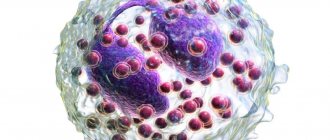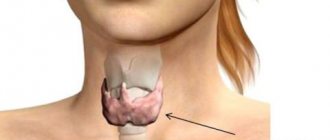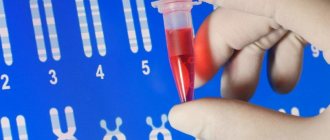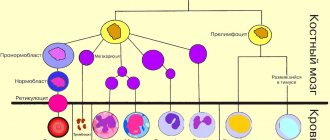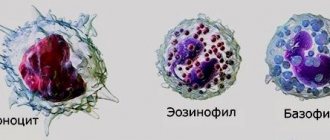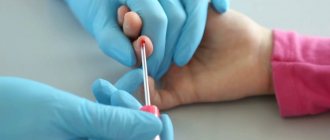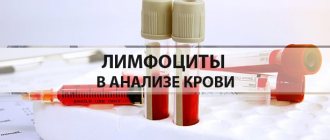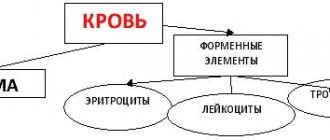What will happen in the video:
1. What are monocytes |
00:22 (in video) 2. Normal monocytes in the blood | 02:49 (in video) 3. Reasons for the increase in monocytes in the blood | 03:42 (in video) 4. Symptoms of increased monocytes in the blood | 06:58 (in video) 5. Increased monocytes in children (monocytosis in children) | 10:39 (in video) Online consultation with infectious disease specialist, allergist-immunologist Natalia Nikolaevna Gordienko
Cost of online consultation: 3500 rubles
Online consultation
During the consultation, you will be able to voice your problem, the doctor will clarify the situation, interpret the tests, answer your questions and give the necessary recommendations.
Read more about blood tests in our article
“Hematological tests: norms and interpretation of results.”
What are monocytes?
Before we begin listing those conditions in which monocytes are elevated in a child, it is worth remembering what kind of cells these are.
Monocytes are large cells circulating in the blood. They are a type of white blood cell. The place of their synthesis is the bone marrow, as well as for other blood cells. There, mature monocytes are formed from an immature precursor. They circulate in the blood for about 20–40 hours, then, entering the tissues, they become macrophages.
According to their structure, they belong to agranulocytic leukocytes. This means that there are no granules with inclusions in their cytoplasm, as, for example, in eosinophils.
There are several types of leukocytes: neutrophils, basophils, eosinophils, monocytes, lymphocytes. The first three are classified as granulocytes, and the last two are classified as agranulocytes.
What function do they perform?
The main function of monocytes is to turn into macrophages. They destroy foreign particles and digest them.
Macrophages are also immunocompetent cells. That is, they bind a foreign particle to our body and “contain” it on their surface. This happens until the killers destroy the particle.
Macrophages take part in the metabolism of fats and pigments, in blood clotting processes, and inflammatory reactions.
In addition to all of the above, macrophages are also capable of synthesizing various biologically active substances, for example, cytokines and coagulation factors.
What is the normal level of monocytes in a child’s blood?
The normal content of monocytes in the blood of children is presented in Table 1.
Table 1. Monocytes are normal in children.
| Age | Norm |
| Children of the first year of life | 0.05 - 1.1 x 10*9/l |
| From one year to 2 years | 0.05 - 0.6 x 10*9/l |
| 24 years | 0.05 - 0.5 x 10*9/l |
| From 4 to 16 years | 0.05 - 0.4 x 10*9/l |
This table shows normal levels of monocytes in the blood in absolute numbers.
Often a person can receive a result in which, in addition to absolute numbers, the content of these formed elements is also indicated as a percentage of other indicators.
In children of the first year of life, the normal content of monocytes is 4–10%, from a year and older – 3–10%.
Normal indicators in adults
In adults, if we talk about absolute values, the level of monocytes in the blood can vary from 0.05 per 10*9/l to 0.82 per 10*9/l. In relative terms, fluctuations within 4–11% are acceptable.
A general blood test in pediatrics is a mirror of a child’s health.
Timely and effective treatment of any disease always depends on a correct diagnosis. Any adult, visiting a pediatrician with their child about an illness, wants his child to recover as quickly as possible. On the other hand, it is very important for the attending physician, in addition to complaints, medical history and the objective condition of a small patient, to have data from laboratory and instrumental examinations when making a diagnosis. The most universal of them are general clinical blood and urine tests. Their value lies not only in the speed and ease of implementation, but also in the highly informative content of the results. A general blood test is always taken on an empty stomach (except in emergency cases), i.e. Before coming for the procedure, you must avoid taking any food and limit your fluid intake. Therefore, blood is taken for analysis in the morning so that the child does not have to starve for a long time. The material for analysis is blood taken from a finger or vein. The importance of this rule is due to the fact that after eating, some indicators (the level of white blood cells - leukocytes, ESR) may deviate from the norm, thereby creating a false picture of the disease. If possible, you need to prevent stress when taking blood from a child over 2 years old by talking with him the day before about the upcoming examination, encouraging him after the procedure, etc. Now for you, dear Parents, a little information about the most frequently determined indicators included in the general blood test form.
Hemoglobin is a substance that is part of red blood cells and acts as a carrier of oxygen and carbon dioxide, consists of protein and iron. Normal hemoglobin levels: – newborns – 160-230 g/l; – children under one year old – 110-130 g/l; – from one to 4 years – 110-140 g/l; – from 4 to 7 years – 110-146 g/l; – from 7 years and older – 110-152 g/l. An increase in hemoglobin levels is observed during high physical activity, excitement, stressful situations, dehydration (vomiting, diarrhea), burns and some blood diseases. A decrease in hemoglobin levels is typical for anemia of various origins, degenerative processes, and may be a side effect of certain medications.
Hematocrit is an indicator indicating what part of the blood volume is occupied by formed elements (cells). The norm for newborns is 40-60%, for children from 2 months to 4 years 30-41%, from 4 years and older 34-43%. An increase in the hematocrit level is observed with blood thickening associated with dehydration or diseases that increase the number of cells (erythremia, leukemia). A decrease in this indicator occurs with anemia.
Erythrocytes are red blood cells that contain hemoglobin. Responsible for the transport of oxygen, carbon dioxide, amino acids, antibodies, drugs and toxins. The lifespan of these cells is 120 days. Normal indicators for children: – from birth to 2 months. — 3.9-6.2 T/l; – from 2 to 4 months. — 3.1-4.5 T/l; – from 4 months to 4 years – 3.0-5.4 T/l; – from 5 years and older – 3.5-5.0 T/l. An increase in the level of red blood cells is characteristic of oxygen starvation, chronic lung diseases, congenital heart defects, some blood diseases and neoplasms. A low level of red blood cells is observed with anemia, infections, helminthic infestations, bleeding, obesity, due to increased background radiation. The cause and form of anemia can be determined by the average volume of red blood cells. For children aged 4 months to 4 years, the norm is 75-115 fL, from 5 to 7 years 76-108 fL, from 8 years and older -76-96 fL. An increase in this indicator is observed in anemia associated with deficiency of vitamin B12, folic acid, liver diseases, dysfunction of the bone marrow and thyroid gland, and after bleeding. A decrease in the indicator is characteristic of iron deficiency anemia; hyperfunction of the thyroid gland; anemia associated with chronic diseases; congenital anemias.
Leukocytes are white blood cells whose main function is to protect the body from foreign influences. Leukocytes participate in inflammatory, allergic, and immune reactions, destroying cell breakdown products, viruses and bacteria. Normal indicators: – for newborns – 13-20 G/l; – for children from 1 week to 1 month – 5-20 G/l; – for children from 1 month to 1 year – 6-15 G/l; – from 1 year to 6 years – 5-14 G/l; – from 6 years and older – 6-11 G/l. An increase in the level of white blood cells (leukocytosis) is observed after acute bleeding; for neoplasms; blood diseases; for most infectious diseases of a bacterial nature (both acute and chronic). Short-term physiological leukocytosis is provoked by food intake, pain, emotional stress, physical effort, and exposure to ultraviolet radiation. A decrease in the level of leukocytes (leukopenia) is observed in infections such as influenza, ARVI, measles, psittacosis, viral hepatitis and malaria. Long-term bacterial infections, depleting the body, also reduce the level of leukocytes. Dangerous causes of leukopenia are blood diseases, autoimmune diseases, and the consequences of exposure to radiation.
The leukocyte formula includes a group of cells of different structure and function (neutrophils, eosinophils, basophils, monocytes, lymphocytes), the quantitative determination of which provides a lot of valuable diagnostic information.
Neutrophils are the most numerous type of leukocytes. According to the degree of maturity, young, band and segmented neutrophils are distinguished. The main function of these cells is protective. Normally, the majority of neutrophils should be represented by segmented cells. The appearance of young forms and a large number of band neutrophils in the child’s blood most often indicates an acute inflammatory process. The normal content of neutrophils in the blood of a child from 4 months to 4 years is 30 - 55%, at the age of 5-7 years - 40 - 60%, 8 - 14 years - 45 - 70%. An increased number of neutrophils is observed during inflammatory processes, after surgical interventions, against the background of bacterial, fungal and some viral infections, parasitic infestations, during intoxication, blood diseases, and neoplasms. A low level of neutrophils is characteristic of anemia, acute viral and chronic infections.
Eosinophils are cells that indicate allergic reactions in the body. In children at any age, the norm is from 1 to 5%. An increase in the rate is observed in allergic diseases: bronchial asthma, urticaria, Quincke's edema, hay fever, hypersensitivity to drugs, a number of skin diseases, scarlet fever, helminthic infestations, and some neoplasms.
Basophils are participants in allergic and inflammatory reactions. Normally, the number of basophils ranges from 0 to 5% of the total number of leukocytes. Of clinical significance is the increase in the number of basophils, which is observed in allergic reactions, leukemia, lymphogranulomatosis, and decreased thyroid function. Lymphocytes are the most active cells of the immune system, taking part in all types of its activities. The level of lymphocytes changes significantly throughout a child's life: in children under 5 years of age, the number of lymphocytes normally exceeds the number of neutrophils, and after 5 years the situation changes to the exact opposite. If at the age of up to 5 years the norm is 45 - 65% of lymphocytes, then by 7 years the normal figure decreases to 30 - 55%, and then at 8 years and older to 20 - 40%. An increased number of lymphocytes in the blood is observed in most viral infections: viral hepatitis, infectious mononucleosis, whooping cough, rubella, cytomegalovirus, herpes, as well as tumor diseases. A decrease in the level of lymphocytes is characteristic of bacterial diseases, tuberculosis, systemic lupus erythematosus, renal failure, bone marrow dysfunction, and immunodeficiency conditions.
Monocytes are also immune response cells. The norm for children of any age is up to 8%. An increase in the rate is observed in viral and fungal infections, septic endocarditis, during recovery from infectious diseases, tuberculosis, neoplasms, and rheumatoid arthritis. A low level of monocytes is characteristic of leukemia, severe forms of anemia, and exhaustion of the body.
Erythrocyte sedimentation rate (ESR). The value of this indicator depends on the viscosity of the blood, the presence of normal and pathological proteins in it, and the number of cellular elements. By itself, the ESR value does not mean anything, however, in combination with other changes in the general blood test and the condition of the child, the indicator can provide very useful and necessary information. For children, the normal level of ESR is considered to be 2-10 mm/h (in newborns 1-2 mm/h, in children under 6 years old the rate can be increased to 15 mm/h). An increase in ESR is observed during infections, inflammatory diseases, anemia, tumors, and while taking certain medications. A decrease in ESR is characteristic of some types of anemia and blood diseases.
Platelets are blood platelets. The main function of platelets is to clot blood and stop bleeding. Normal values for children under 7 years of age are 150 - 400 G/l, 8 - 14 years old - 150 - 380 G/l. An increase in platelet levels is observed in cases of blood cancer, tuberculosis, rheumatoid arthritis, anemia, after surgery or physical activity. A decrease in the rate is typical for viral and bacterial infections, chronic bleeding, liver and kidney diseases, severe anemia, diseases of the immune system, tumors, congenital heart defects, and impaired thyroid function.
Dear parents, I would like to draw your attention: the limits of normal blood counts may vary depending on the laboratory that conducted the study. Therefore, always compare the results obtained with the reference values indicated in the analysis form!
The results of a general blood test can only be interpreted in conjunction with all available medical information: taking into account complaints, medical and life history, examination data, and the results of other laboratory and instrumental examinations.
Only an experienced doctor can understand such a volume of information, so be sure to discuss the results of your child’s general blood test with your pediatrician.
Be healthy!
What method is used to determine the level of monocytes in the blood?
The content of monocytes is determined in a general blood test when calculating the leukocyte formula.
The leukocyte formula is a common method for counting types of leukocytes. 100 cells in a blood smear are counted, noting on a special counter which category of leukocytes they belong to.
In an automatic analyzer that examines blood, granulocytes and cells that do not contain inclusions can be counted. For more accurate differentiation, you have to count them manually under a microscope.
However, modern laboratories in large cities can be equipped with the latest technology, that is, those blood analyzers that count individual fractions of leukocytes.
How to prepare for the test?
The level of monocytes is determined in the blood, so it is important to avoid the influence of various factors on the results.
Blood must be donated on an empty stomach after an overnight fast. For infants - half an hour before the next feeding. In children under 3 years old - 3-4 hours after eating.
The patient needs physical and emotional rest. Stress and physical activity may affect the results of the study.
Calm the child down and explain what will happen in the blood collection room. A child should not be afraid of doctors and nurses. You can reward his good behavior with some sweets or a trip to the park.
If the patient is taking any medications, it is necessary to inform the doctor about this to exclude their influence on the result.
Before giving a referral for any test, a competent specialist should advise the patient on how to properly prepare for the test.
Analysis transcript
Increased monocytes
In cases where monocytes in a child’s blood are elevated, they speak of monocytosis.
Reasons that cause monocytosis in children:
- infections of various etiologies: tuberculosis, brucellosis, viruses, syphilis and others;
- malignant neoplasms;
- autoimmune pathology;
- multiple myeloma;
- monocytic leukemia;
- sarcoidosis
Low content
Low levels of monocytes in the blood are called monocytopenia. Monocyte deficiency in the blood is a fairly rare phenomenon. It can be detected, for example, in aplastic anemia.
There is evidence that the use of prednisolone leads to a decrease in monocytes in the blood.
Causes of monocytosis in children
If, after a thorough blood test, it turns out that the child’s monocytes are higher than normal, you need to sound the alarm. There are many reasons for this disorder.
The most common, as in cases with adults, is the onset of the development of an infectious disease. As a rule, this is not difficult to understand, since the baby begins to have a runny nose, cough, or some other manifestation.
However, cases in which monocytes increase, on the contrary, during the recovery period after suffering a serious illness are not uncommon. In such situations, this phenomenon is considered the norm and only indicates that the body is working.
Monocytes often increase after surgery. If none of the above applies to the baby, then most likely there are blood diseases.
ONLINE REGISTRATION at the DIANA clinic
You can make an appointment by calling the toll-free phone number 8-800-707-15-60 or filling out the contact form. In this case, we will contact you ourselves.
What to do if deviations from the norm are detected?
First of all, don’t panic or get upset. It is worth showing your test results to a competent doctor.
A hematologist specializes in blood tests and more. He will be able to answer all your questions, give competent advice, and prescribe a proper examination of the body.
To further examine and search for the true causes of abnormal monocyte levels, specialists resort to various studies: from X-ray examination to studying the material obtained after bone marrow puncture. The main thing is to promptly identify breakdowns that have occurred in the body (both in adults and children) and prescribe adequate treatment.
Average cost of analysis in Russia
A general clinical blood test with calculation of the leukocyte formula can be done free of charge under the compulsory medical insurance policy at your medical organization.
You can also get tested for a fee. On average, a general clinical blood test along with a leukocyte count will cost between 400 and 600 rubles. You can only request a white blood cell count. Such a study will cost 250–350 rubles.
I would recommend examining the level of leukocytes along with a general clinical blood test. The indicators together help to choose the right direction for further diagnostic measures.
And who is to blame for the infection?
When you know which blood cells are responsible for what, using a blood test to figure out what kind of infection has attacked the child this time is not easy, but simply simple. A high ESR and high leukocytes mean that the infection is in full swing and it must be treated immediately (in addition to these indicators, there is most often a temperature above 38C). High neutrophils mean that we have met another bacteria, and high lymphocytes mean a viral infection.
Everything is simple, as you can see. Now let's look at examples. And in order not to get confused in the numbers, we will simply say “a lot” or “a little”. Shall we try?
Acute viral infection
Signs . Leukocytes and ESR are higher than normal, in the leukocyte formula there is an excess of lymphocytes, a decrease in the number of neutrophils. Monocytes and eosinophils may increase slightly.
What to do ? Most often, doctors prescribe drugs containing interferon - viferon, kipferon or genferon.
Important! The so-called intracellular parasites - chlamydia and mycoplasma - behave exactly like viruses. They can be distinguished by the clinical manifestations of the disease. The “calling card” of both is a prolonged dry cough with an extremely unclear external picture - the child looks active, there is no wheezing in the lungs. However, the cough may last for weeks.
Chronic viral infection
Signs . The child is often sick, the blood has a normal ESR and normal (or even low) leukocytes. In the leukocyte formula, lymphocytes and monocytes float at the upper limit of normal. Neutrophils are at the lower limit of normal or even lower.
What to do? Examine the child for antibodies to Epstein-Bar viruses and cytomegalovirus. Most likely, these two are to blame.
Important! If the child has just had a viral infection, the blood test will be exactly the same. So, if a child gets sick twice a year and has just suffered a viral runny nose, it is somewhat premature to run to get tested for chronic viral infections.
Advertising
Acute bacterial infection
Signs. Leukocytes and ESR are higher than normal, in the leukocyte formula there is an excess of neutrophils (or even monocytes along with them) against the background of a decrease in the number of lymphocytes. Externally, signs of inflammation are visible, such as fever, purulent nasal discharge, wheezing in the lungs or a wet cough.
What to do? The most common medical prescriptions with such a blood test are antibiotics of the penicillin group (Augmentin, Flemoklav, Solutab, Suprax), less often - antibiotics of the azalide group (Vilprofen, Sumamed).
